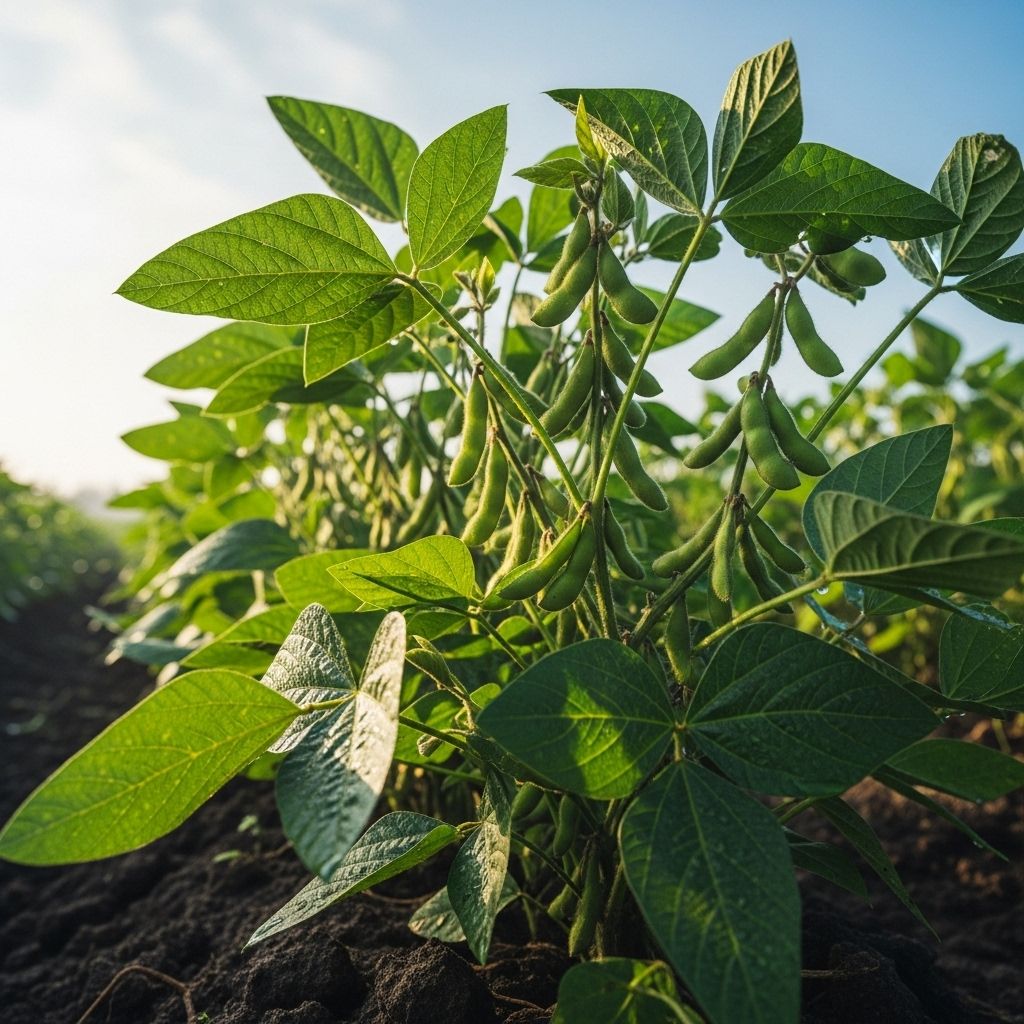How To Grow Soybeans: Expert Tips For Edamame Success
Clear planting and care advice ensures backyard harvests yield tender protein snacks.

How to Grow Soybeans: A Comprehensive Guide to Edamame from Seed to Harvest
Soybeans, known for their edible, protein-rich pods called edamame, offer a rewarding crop for home gardeners. Whether you’re looking to grow your own healthy snacks or diversify your vegetable garden, learning how to cultivate soybeans from scratch is practical and straightforward. This guide outlines everything from selecting the right seeds to harvesting, storing, and troubleshooting common problems.
Table of Contents
- About Soybeans and Edamame
- Planting Soybeans
- Caring for Soybean Plants
- Harvesting and Storing Soybeans
- Troubleshooting and Common Issues
- Frequently Asked Questions
About Soybeans and Edamame
Soybeans (Glycine max) are annual legumes native to East Asia, prized globally for their nutritional value. While edamame refers to soybeans that are harvested green and consumed fresh, mature soybeans are also used for making tofu, tempeh, soy milk, and numerous other products.
- Soybeans are a warm-season crop, sensitive to frost, and require a long growing season with at least 80 frost-free days.
- Edamame is typically picked while the pods are still young, green, and tender—before the seeds fully mature and harden.
- Home-grown soybeans are fresher and often tastier compared to store-bought options.
Planting Soybeans
Optimal planting is crucial for strong, healthy soybean plants. The following sections cover when and how to plant soybeans for best results.
When to Plant
- Plant soybeans directly after the last spring frost when soil temperatures reach at least 60°F (16°C).
- Soybeans thrive in USDA Hardiness Zones 2–11.
- Sow when air temperatures consistently stay above 70°F (21°C) for best germination.
Choosing Seeds
- Select disease-resistant varieties suitable for your region.
- Don’t use supermarket edamame beans for planting as they are often blanched or unsuitable for germination.
- Buy certified seed from reputable sources.
Site Selection and Preparation
- Soybeans require full sun—at least 8 hours of direct sunlight daily. Less light results in poor yields.
- Pick a spot with well-drained, loose, and moderately fertile soil rich in organic matter.
- Prepare garden beds by incorporating compost and gently raking soil to break up clumps.
- Avoid waterlogged sites, as soybeans dislike ‘wet feet.’
How to Plant Soybeans
- Direct-Sow Seeds in prepared beds at a depth of 1–1.5 inches (2.5–4 cm). Do not presoak seeds.
- Space seeds about 2–4 inches (5–10 cm) apart in rows 18–24 inches (45–60 cm) apart.
- Alternatively, thin seedlings to 6 inches (15 cm) apart when they reach 4 inches tall.
- Press soil gently over seeds and water well but avoid saturating the soil.
Container Gardening: Soybeans can be successfully grown in large containers or raised beds. Use at least a 10-gallon container filled with a mixture of compost, peat, and perlite for good drainage.
Caring for Soybean Plants
Once your soybeans are established, consistent care is essential to maximize growth and yield.
Sun and Temperature Requirements
- Provide full sun (8+ hours per day); partial shade reduces yields.
- Optimal temperature: 70–95°F (21–35°C). Plants stop growing below 60°F (16°C) and above 100°F (38°C).
- Soybeans are not frost-hardy; protect from any risk of late spring or early fall frosts.
Watering
- Keep soil consistently moist; aim for 1 inch (2.5 cm) of water weekly during the growing season.
- Ensure well-draining soil to prevent root rot; avoid soggy conditions.
- Mulch around plants to conserve soil moisture and suppress weeds.
Feeding and Fertilizing
- Soybeans are nitrogen-fixing; they generally do not need high-nitrogen fertilizer.
- In soil poor in phosphorus or potassium, add a balanced organic fertilizer before planting.
- Avoid over-fertilization, which can result in lush leaves but poor pod production.
Pruning
- Most home garden soybean varieties reach 2 feet tall and do not require pruning.
- Prune only if plants grow too large or encroach on other crops.
Support and Spacing
- Soybeans are bushy and generally do not need staking.
- Maintain ample space between rows so plants mature fully and air circulation is maximized.
Companion Planting
- Good companions: corn, potatoes, cucumbers, strawberries.
- Poor companions: alliums (such as onions and garlic), which inhibit legume growth.
Propagation
- Soybeans are best propagated from direct sown seeds at 1–1.5 inches deep, when soil is at least 60°F.
- Do not soak seeds prior to planting; excess water may cause them to rot before germination occurs.
Harvesting and Storing Soybeans
Timing is key for harvesting soybean pods at their peak flavor and nutrition, whether you plan to eat them fresh or store them for future use.
When to Harvest Edamame
- Soybeans mature in 75–90 days after sowing, depending on the variety.
- For edamame, pick pods when they are plump, bright green, and slightly furry. Avoid waiting too long or pods will become tough and seeds harder.
- The whole plant can be cut at soil level for one-time harvests, or pick pods continuously as they mature.
How to Harvest
- Use scissors or garden shears to snip off pods directly from the stems.
- If harvesting the whole plant, uproot or cut at ground level and remove pods for processing.
Storing Fresh Soybeans
- Use fresh pods within 2–3 days if storing in the refrigerator for the best flavor and texture.
- For longer storage, blanch fresh pods in boiling water for three minutes, cool in ice water, drain thoroughly, and freeze in airtight containers.
Storing Mature Dry Soybeans
- Allow some pods to dry on the plant late in the season for harvesting mature, dry beans.
- Shell dry beans and store them in a cool, dry, airtight container for up to a year.
| Harvest Stage | Indicators | Usage |
|---|---|---|
| Edamame (Green) | Plump, green pods; seeds soft | Fresh eating, blanch & freeze |
| Mature (Dry) | Pods yellow/brown, seeds hard | Dry beans for storage, seed saving |
Troubleshooting and Common Issues
Though soybeans are relatively easy to grow, several issues can affect plant health and productivity. Address these quickly for best results.
Common Problems and Solutions
- Poor Germination: Usually due to cold soil; plant when temperatures are consistently above 60°F.
- Yellow Leaves: May indicate overwatering or soggy soil; ensure proper drainage.
- Leaf Damage: Aphids, spider mites, and beetles can infest plants; use organic insecticidal soap or remove pests by hand.
- Fungal Issues: Caused by poor air circulation or wet foliage; water at the base of plants and avoid overhead irrigation.
- Root Rot: Avoid planting in heavy, poorly drained soil.
- Poor Pod Set: Often due to shade, drought, or excess nitrogen fertilizer.
Disease Prevention
- Rotate bean crops each year to prevent soil-borne diseases.
- Remove plant debris promptly at season’s end.
- Avoid working around plants when foliage is wet to limit disease spread.
Frequently Asked Questions
Q: Can I grow edamame/soybeans in containers?
A: Yes. Use containers at least 10 gallons in size with rich, well-drained soil. Be sure to water regularly and provide ample sunlight.
Q: How long do soybeans take to mature?
A: Most home garden varieties mature in 75–90 days, but maturity time may vary depending on the specific cultivar and climate.
Q: When is the best time to harvest edamame?
A: Harvest when pods are plump, green, and seeds inside are about 80% developed but still tender and soft.
Q: Do soybeans need a lot of water?
A: While soybeans are drought-tolerant once established, consistent moisture is vital during flowering and pod filling for optimal yields.
Q: Can I save seeds from my soybean crop?
A: Yes. Allow some pods to fully dry on the plant, shell the beans, and store them in a cool, dry place for next year’s planting.
Additional Tips for Success
- Weed regularly to minimize competition for nutrients and water.
- Mulch with straw or shredded leaves to prevent moisture loss and suppress weeds.
- Plant multiple short rows for better results, easier harvesting, and improved disease management.
- For continuous supply, succession plant a new batch of soybeans every 2–3 weeks through late spring and early summer.
Conclusion
Soybeans are an accessible, nutritious legume that fit seamlessly into both small backyard plots and larger home gardens. By following the outlined planting schedules, care techniques, and harvesting advice, gardeners of all experience levels can enjoy fresh, homegrown edamame and soybeans throughout the season.
References
Read full bio of Anjali Sayee












